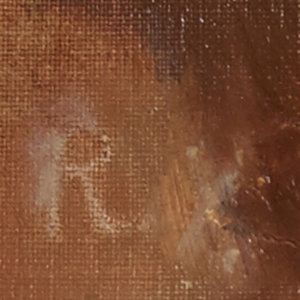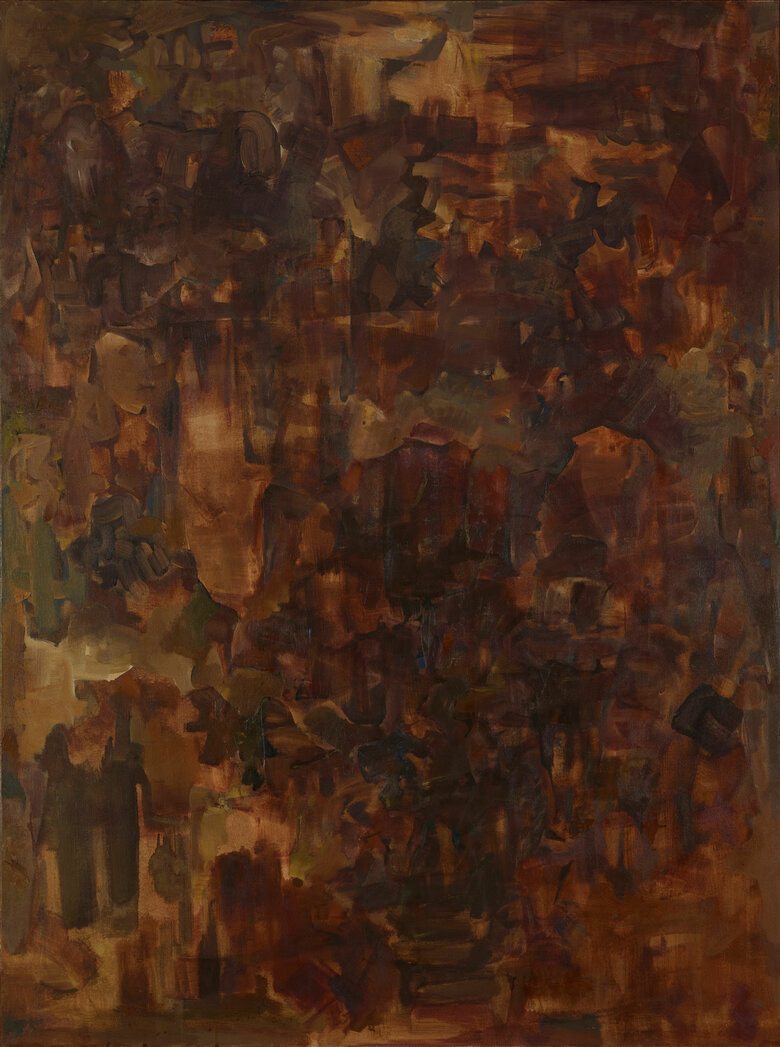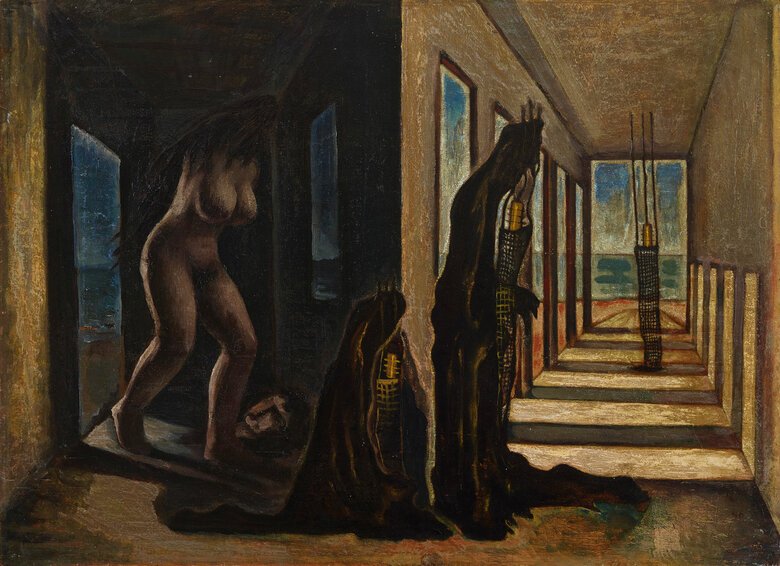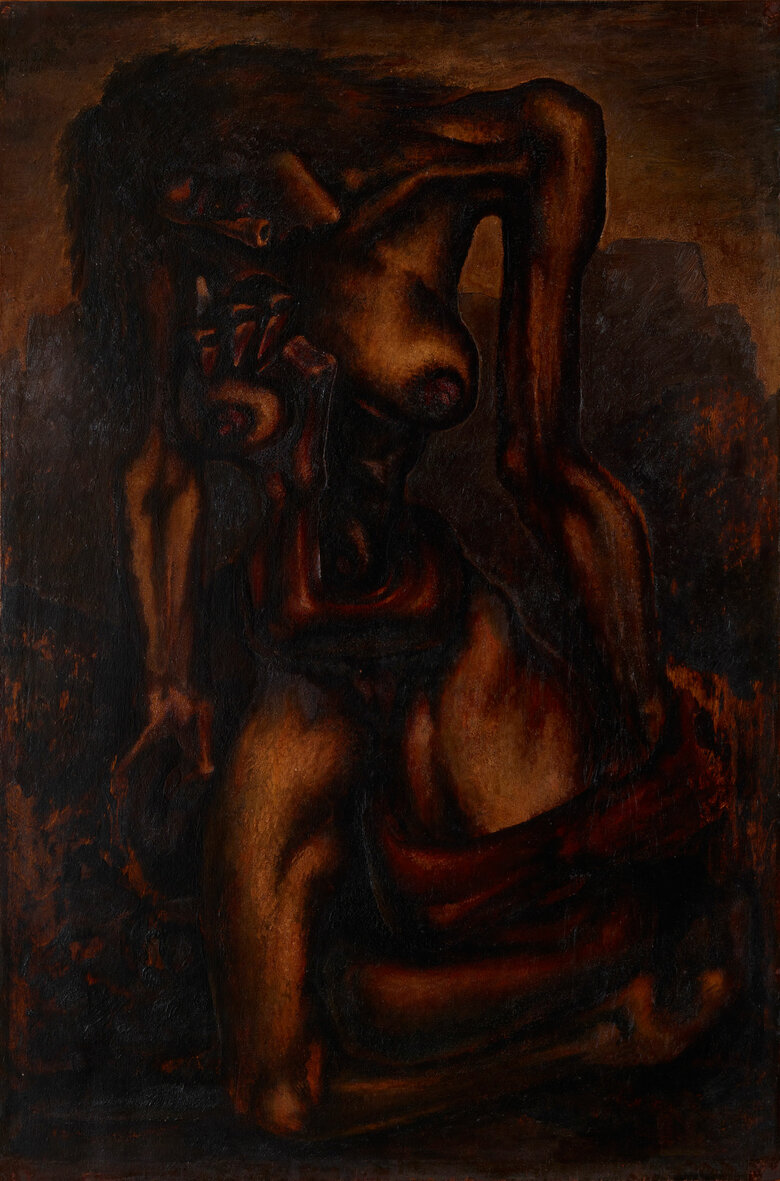Written by Arthur Debsi Born in 1913 in the city of Minyah, Egypt, Ramses Younan grew up in a modest, and Coptic family. In 1929, he enrolled in the School of Fine Arts, and started a teaching...


RAMSES YOUNAN, Egypt (1913 - 1966)
Bio
Written by Arthur Debsi
Born in 1913 in the city of Minyah, Egypt, Ramses Younan grew up in a modest, and Coptic family. In 1929, he enrolled in the School of Fine Arts, and started a teaching career in public schools all around the country, right after he obtained his teaching certificate in 1934. The following year, Younan joined the group called Jama’at al-Daa’ya al-Faniyya (Art Advocates Society), founded in 1933 by the Egyptian artist Habib Gorgi (1892-1965), and some art educators such as Youssef al-Afifi, and Hussein Youssef Amin (1904-1984). The group contributed to the promotion of art education in Egypt, and published the book entitled Ghayat al-Rassam al-‘asri (The Aim of the Contemporary Artist), written by Ramses Younan in 1938. The latter would eventually join the group of Art and Liberty, which initially stood up against the Fascist movement, and ideology from Europe, having reached Egypt in the mid-1930s. With a versatile profile, Younan actively participated in the introduction, the elaboration, and the spreading of the Art and Liberty ideas. And his thought was regularly published in several articles, including ‘From Dada to Surrealism’ in 1942, and ‘The Decision belongs to the People’ in 1943, all issued in the leftist magazine Al-Majallah Al-Jadidah (The New Magazine) – founded by Salama Musa (1887-1957) in 1929. The remarkable work of Ramses Younan was such that he became editor of the magazine from 1941 to 1944, the year it was banned by the state[1]. This magazine tackled different subjects such as societal problems, arts, and politics; which consequently made it a great medium of expression for the artists of Art and Liberty. However, due to his political commitment, and activities, Ramses Younan was arrested in 1946. After being released, he traveled to France in 1947, where he settled in Paris. There, he pursued the painting, and simultaneously worked for the French National Radio between 1952 and 1956. On July 16th 1956, the government of President Gamal Abdel Nasser (1918-1970) nationalized the Suez Canal Company, and the troops of Israel invaded the Sinai, followed by the bombing attack of France, and Great Britain[2]. Concerning this event, Younan was somehow torn between the new nationalist, and revolutionary vision of Egypt, and the French imperialistic politics. And because he didn’t want to take any position in favor of France on the radio, he left the country to go back to Egypt in 1956. In 1960, the Egyptian Ministry of Culture granted him support, enabling him to fully dedicate his time to painting.
On December 22nd, 1938, Art and Liberty announced their bi-lingual, Arabic-French manifesto named Yahya al-Fann al-Munhatt (Long Live Degenerate Art), which was signed up by artists, but also writers, journalists, and lawyers. They firmly condemned the rise of the Hitlerian power, and ideology in Europe, as they stated: ‘[In Vienna] Works by great German [sic] artists such as Marx Ernst, Paull Klee, Karl Hofer, Oskar Kokoschka, George Grosz, and Vasily Kandinsky have been confiscated and replaced by worthless National Socialist art’[3]. They consequently proposed an innovative artistic program, which corresponded to the contemporary times, and the social realities of Egypt. Indeed, the group of Art and Liberty demonstrated in a various artistic production, which included paintings, installations, and also photography, the fears, and anxiety, of a generation living in wartime.
When it comes to the study of Ramses Younan’s career, it is important to note that he was also an important intellectual, and the author of a consequentially written oeuvre. First, he is known for the translations into Arabic from French literature, like the bundle of poems entitled Une Saison en Enfer by the French poet Arthur Rimbaud (1854-1891), as well as the play Caligula by the writer Albert Camus (1913-1960). On the other side, his writings exposed his theoretical, and philosophical ideas about art, which were mainly in the foundation of the Art and Liberty group’s development. Thus, Younan defined the group, and its scope, taking a critical view of Surrealism in Europe, especially in the book Ghayat al-Rassam al-‘asri (The Aim of the Contemporary Artist). He effectively engaged an analysis of the movement in Europe, and highlighted the dimensions, that it could take: ‘The art of this group [Surrealist Artists] is liable to degenerate into an artificial, forced art that demonstrates the wit and skill of the conscious mind more than the specters and impulses of the unconscious’[4]. To Ramses Younan, although the artistic approach of the Surrealist artists in Europe was avant-garde, it still belonged to the ‘bourgeois mythology’, which provided an illusion in favor of capitalism, and bourgeois existence[5].
In the 1940s, the oeuvre of Ramses Younan highly followed the thought, that Surrealism could be associated to a moral, and social revolution. Nevertheless, the painter stressed the project of shaping a new form of Surrealism, that he would call ‘Subjective Surrealism’. This new form encouraged the artists to integrate identifiable symbols in their works, through a completely free creative process. Like his colleagues, Younan depicted the portrait of a society, which experienced the poverty in Egypt during the years of WWII, and in particular the problem of the prostitution. In 1940, Ramses Younan wrote an article, Al-Bagha’ Mushkilah laha Juthour (Prostitution is a Problem with Roots) for the periodical Al-Tatawwur (Evolution), denouncing the fact that, because of the extreme poverty in Egypt, some women were forced to work in brothels. From this period, the artist produced works such as La Passion Sauvage (1940), part of the Dalloul Art Foundation’s collection, where he expressed another vision of the female body, which would embody the social issues. Here, he decided to use a dark palette of colors, with a combination of red, and earthy tones, in order to insist on the frightful, and gloomy atmosphere of the scene. In the middle of the composition, he illustrated a naked woman, who is screaming, and seems to be in profound distress. Detached from any academic painting rules, which commonly value the beauty of the female body, Ramses Younan chose to dehumanize the one of his character. As a matter of fact, he intentionally ripped apart, and distorted the body, while he exaggerated the muscles of the arms, and the legs. On another level, he created a sort of a beast, or monster, with nipples of the woman’s breasts looking like bulging eyes; and the stomach becoming jaws. The woman is mutilated, and resembles a skeleton. The Egyptian Surrealist artists were extremely cultivated, and had a strong knowledge in the psychoanalytic theories of the Austrian neurologist Sigmund Freud (1856-1939), which nurtured their artistic reflection. In La Passion Sauvage, Ramses Younan offered a rich narrative interpretation of the several struggles, from which the woman is suffering: a physical struggle due to the wartime, an inner one with the subconscious, an outer one with the conventions, imposed on her by the society.
The surrealist environment, in which Ramses Younan took the public, is readily apparent in Untitled (1946), also part of the Dalloul Art Foundation’s collection. The painter illustrated an imaginary scene, in which he again worked on the dismantling of the physical reality. Playing with the shadows, and the light, he integrated in the composition some enigmatic figures, and only a woman is identifiable. The latter is naked, and her long dark hair completely covers her head, while she is walking. By her feet, a head of a man is placed on the floor; and in the middle of the scene, appear two other figures, which recall creatures of darkness, carrying a kind of oil lamp. It is difficult for the viewer to clearly identify the elements, and the actual meaning of the painting. Ramses Younan rendered a world close to the one of the subconscious, the dreams, which are free from any reasonable logic, and mental mechanism. This peculiar plastic treatment manifested his new artistic vision that would replace what he called the ‘bourgeois mythology’. He explained this approach in the two following essays La Désagrégation des mythes (The Disaggregation of Myths), and Notes sur une ascèse hystérique (Notes on a Hysterical Asceticism), by presenting the importance of the artist’s role, and the dimension, which a painting should take. In his writings, he tended to discredit truth, and its control over fiction[6]; and considered the notion of ‘falseness’ to have a powerful part in the act of creation. Yet, as the Surrealist movement was declining, many Egyptian artists moved towards abstract art. As of 1960s, Ramses Younan produced abstraction seen in the two examples Untitled, both dated from 1964. Using warm earthy colors, Younan filled the surface of the canvas with heavy, and thick brushstrokes. Abstraction, which was also linked to the traditional ancient Egyptian art, could be another alternative to express the free imagination of people, and reflect a form of the unconscious.
According to Ramses Younan, the movement of Surrealism in Europe, was still in a phase of experimentation[7]. Through his painted, and written work, he succeeded in proposing another artistic, and theoretical vision of Surrealism, which occurred in Egypt as another contribution to the European artistic avant-garde.
Ramses Younan passed away in 1966.
[1] Flores, Andrea. “The Myth of the False - JSTOR,” 2000. https://www.jstor.org/stable/27933782. [P.99]
[2] “Guerre De Suez 1956.” Le Monde diplomatique. Accessed October 7, 2020. https://www.monde-diplomatique.fr/index/sujet/guerredesuez.
[3] Lenssen, Anneka, A. Rogers, Sarah, and Shabout, Nada. Modern Art in the Arab World, Primary Documents. New York, USA: The Museum of Modern Art, 2018. [p.94]
[4] Younan, Ramses. Ghayat al-Rassam al-‘asri pamphlet (excerpt) (Cairo: Jama’at al-Di’aya al-Fanniya, 1938); repr. In Dirasat fi al-Fann (Cairo: Dar al-Kitab al-‘Arabi, 1969), 16-35. Translated from Arabic by Mandy McClure. In Lenssen, Anneka, A. Rogers, Sarah, and Shabout, Nada. Modern Art in the Arab World, Primary Documents. New York, USA: The Museum of Modern Art, 2018. [p.93]
[5] Flores, Andrea. “The Myth of the False - JSTOR,” 2000. https://www.jstor.org/stable/27933782. [P.102]
[6] Flores, Andrea. “The Myth of the False - JSTOR,” 2000. https://www.jstor.org/stable/27933782. [P.105]
[7] Bardaouil, Sam, and Fellrath, Till. Art Et Liberté, Rupture, War and Surrealism in Egypt (1938-1948), [Exhibition catalogue, ‘Art Et Liberté, Rupture, Guerre Et Surréalisme En Égypte (1938-1948)’. Paris, Centre Georges Pompidou, October 19th 2016 – January 16th 2017]. Paris, France: Skira, 2016. [P.27]
Sources
Bardaouil, Sam, and Fellrath, Till. Art Et Liberté, Rupture, War and Surrealism in Egypt (1938-1948), [Exhibition catalogue, ‘Art Et Liberté, Rupture, Guerre Et Surréalisme En Égypte (1938-1948)’. Paris, Centre Georges Pompidou, October 19th 2016 – January 16th 2017]. Paris, France: Skira, 2016.
Eigner, Saeb. Art of the Middle-East, Modern and Contemporary Art of the Arab World and Iran. London, UK: Merell Publishers Limited, 2011.
Flores, Andrea. “The Myth of the False - JSTOR,” 2000. https://www.jstor.org/stable/27933782.
Kanafani, Fatenn Mostafa. “The Permanent Revolution: From Cairo to Paris with the Egyptian Surrealists,” 2016. https://www.academia.edu/30032558/The_Permanent_Revolution_From_Cairo_to_Paris_with_the_Egyptian_Surrealists.
Kane, Patrick. "Art Education and the Emergence of Radical Art Movements in Egypt: The Surrealists and the Contemporary Arts Group, 1938-1951." The Journal of Aesthetic Education 44, no. 4 (2010): 95-119. Accessed September 10, 2020. https://www.jstor.org/stable/10.5406/jaesteduc.44.4.0095
Karnouk, Liliane. Modern Egyptian Art, 1920-2003. Cairo, New York, Egypt, USA: The American University in Cairo Press, 2005.
Lenssen, Anneka, A. Rogers, Sarah, and Shabout, Nada. Modern Art in the Arab World, Primary Documents. New York, USA: The Museum of Modern Art, 2018.
Mostafa Kanafani, Fatenn. “The Island of Hope, How the Art and Liberty Group Sought to Save Egypt from Itself,” 2016. https://rawi-magazine.com/articles/egyptian_surrealists/.
Mostafa Kanafani, Fatenn. “The Permanent Revolution: From Cairo to Paris with the Egyptian Surrealists Two Independent Exhibitions Commemorate an Important Chapter of Egyptian Modernism,” 2016. https://www.madamasr.com/en/2016/11/11/feature/culture/the-permanent-revolution-from-cairo-to-paris-with-the-egyptian-surrealists/.
Monciaud, Didier. “Polémique Autour De Salama Mûsa : Enjeux De Nationalité, Nationalis...,” July 7, 2008. https://journals.openedition.org/ema/699.
Radwan, Nadia. Les Modernes D'Egypte: Une Renaissance Des Beaux-Arts Et Des Arts Appliqués (1908-1938). Berne, Switzerland: Peter Lang AG., 2017.
Seggerman, Alex. “Al-Tatawwur (Evolution): An Enhanced Timeline of Egyptian Surrealism.”, 2013.
“Guerre De Suez 1956.” Le Monde diplomatique. Accessed October 7, 2020. https://www.monde-diplomatique.fr/index/sujet/guerredesuez.
CV
Selected Solo Exhibitions
2009
Abaad room, Museum of Modern Egyptian Art, Cairo, Egypt
1998
Karim Francis – Contemporary Arts Gallery, Cairo, Egypt
1978
Centre Culturel Français, Cairo, Egypt
1973
Centre Culturel Français, Cairo, Egypt
1972
Galerie des Beaux-Arts, Cairo, Egypt
1967
Atelier du Caire, Cairo, Egypt
1963
Galerie des Beaux-Arts de Bab el-Louq, Cairo, Egypt
1948
Galerie Nina Dausset, Paris, France
1945
Foyer d’art du Lycée Français, Cairo, Egypt
Selected Group Exhibitions
2024
Arab Presences: Modern Art And Decolonisation: Paris 1908-1988, Musée d'Art Moderne de Paris, Paris, France
2023
Partisans of the Nude: An Arab Art Genre in an Era of Contest, 1920-1960, Wallach Art Gallery, Columbia University, New York City, United States
UNTITLED Abstractions, Dalloul Art Foundation, Beirut, Lebanon
2022
Taking Shape: Abstraction from the Arab World, 1950-1980s, Herbert F. Johnson Museum, Cornell University, Ithaca, United States of America
Taking Shape: Abstraction from the Arab World, 1950-1980s, Block Museum of Art of Northwestern University, Evanston, United States of America
Surrealism Beyond Borders, Tate Modern, London, United Kingdom
2021
Monaco-Alexandrie, le grand detour. Villes-Mondes et surréalisme cosmopolite, NMNM – Villa Sauber, Monaco, France
Surrealism Beyond Borders, The Metropolitan Museum of Art, New York, United States of America
Taking Shape: Abstraction from the Arab World, 1950-1980s, Tampa Museum of Art, Tampa, United States of America
Memory Sews Together Events that hadn’t Previously Met, Sharjah Art Museum, Sharjah, United Arab Emirates
Taking Shape: Abstraction from the Arab World, 1950-1980s, McMullen Museum of Art at Boston College, Boston, United States of America
2020
Taking Shape: Abstraction from the Arab World, 1950-1980s, Grey Art Gallery, New York University, New York, United States of America
2018
A Century in Flux, Highlights from the Barjeel Art Foundation, Sharjah Art Museum, Sharjah, United Arab Emirates
Art et Liberté, Rupture, War and Surrealism in Egypt (1938-1948), Moderna Museet, Stockholm, Swede
Art et Liberté, Rupture, War and Surrealism in Egypt (1938-1948), Tate Liverpool, Liverpool, United Kingdom
2017
Modern Art from the Middle East, Yale University Art Gallery, New Haven, United States of America
Art et Liberté, Rupture, War and Surrealism in Egypt (1938-1948), Kunstsammlung Nordrhein-Westfalen,Düsseldorf,Germany
Art et Liberté, Rupture, War and Surrealism in Egypt (1938-1948), Museo Nacional Centro de Arte Reina Sofia, Madrid, Spain
2016
When Arts Become Liberty: The Egyptian Surrealists (1938-1965), Palace of Arts, Cairo, Egypt
Art et Liberté, Rupture, guerre et surréalisme en Égypte (1938-1948), Centre Pompidou, Paris, France
The Short Century, Sharjah Museum, Sharjah, United Arab Emirates
2013
Tajreed, A Selection of Arab Abstract Art, 1908-1960, Contemporary Art Platform, Kuwait
Le Théorème de Nefertiti, Institut du Monde Arabe, Paris, France
Tea with Nefertiti, Mathaf: Arab Museum of Modern Art, Doha, Qatar
2012
Le Corps découvert, Institut du Monde Arabe, Paris, France
1976
L’Art Égyptien contemporain, Salon des Indépendants, Paris, France
1975
Salon d’Automne, Akhenaton gallery, Cairo, Egypt
1974
Exposition de l’association des anciens élèves de l’École des Beaux-Arts du Caire, Cairo, Egypt
1972
L’Art égyptien contemporain, Grand Palais, Paris, France
1971
Visages de l’art contemporain égyptien, Musée Galliera, Paris, France
1968
Rétrospective des artistes boursiers de l’État, 1960-1966, Cairo, Arab Socialist Union
1967
Paintings of contemporary artists of the U.A.R, Montreal, Canada
1964
The 32nd Venice Biennial, Venice, Italy
1963
The 5th Alexandria Biennial, Alexandria, Egypt
1962
Exposition des artistes boursiers de l’État, Manasterly Palace, Cairo, Egypt
Exhibition of abstract art, L’Art pour Tous gallery, Cairo, Egypt
Exhibition of contemporary Egyptian art, Belgrade, Yugoslavia
1961
Exposition des artistes boursiers de l’État, Museum of Modern Egyptian Art, Cairo, Egypt
The 6th São Paulo Biennial, São Paulo, Brazil
The 1st Yugoslav Triennial of Plastic Arts, Praha, Yugoslavia
Salon d’Automne, L’Art pour Tous gallery, Cairo, Egypt
1960
Impressions d’Égypte, L’Art pour Tous gallery, Cairo, Egypt
1959
Encore l’Inconnu, Galerie Cultura, Cairo, Egypt
Vers l’Inconnu, Galerie Cultura, Cairo, Egypt
1947
Mezinárodni surrealismus, Topic gallery, Prague, Czechoslovakia
XIVème
Exposition des surindépendants, Paris, France
Le Surréalisme en 1947: exposition internationale du surréalisme, Galerie Maeght, Paris, France
Travaux automatiques, Foyer d’art du Lycée Français, Cairo, Egypt
1940-
1945
Ière, IIème, IIIème, IVème, Vème Exposition de l’Art Indépendant, Foyer d’art du Lycée Français, Cairo, Egypt
1938
Exposition du groupe de Propagande artistique, Cairo, Egypt
1933-
1937
Salon du Caire, Cairo, Egypt
Affiliations and Memberships
1939
Art et Liberté Group
Collections
H.E.Sh. Hassan M. Al Thani collection, Doha, Qatar
Institut du Monde Arabe, Paris, France
Mathaf: Arab Museum of Modern Art, Doha, Qatar
May Moein Zeid & Adel Youssry Khedr collection, Cairo, Egypt
Tate Modern, London, United Kingdom
The Barjeel Art Foundation, Sharjah, United Arab Emirates
The Museum of Modern Egyptian Art, Cairo, Egypt
The Ramzi and Saeda Dalloul Art Foundation, Beirut, Lebanon
Documents
Al-Tatawwur (Evolution): An Enhanced Timeline of Egyptian Surrealism
Alexandra Dika Seggerman
Iowa Research Online, English, 2013
Essay
إسطورة رمسيس يونان :...و يا ليته يبكي
Hassan Soliman
Medina Portal, Arabic, 2018
Ramsis Younan Artiste Defunt (1913-1966)
وزارة الثقافة قطاع الفنون التشكيلية, Arabic, French, 2011
Catalog
The Double Game of Egyptian Surrealism: How to Curate a Revolutionary Movement
Jonathan Guyer, Surti Singh
lareviewofbooks.org, English, 2017
Book Review
The Myth of the False: Ramses Younan's Post-Strucuralism avant la lettre
Andrea Flores
The Arab Studies Journal, English, 2000
The Nile of Surrealism: Egyptian Surrealism
Abdel Kader El-Janabi
English, 1987
Hommage a la peinture de R. Younane
Georges Henein
French, 1945
Letter
The World of Mahmoud Said
Ramses Younan
El-Megala Magazine, English, 1964
Magazine
Pousse par ses besoins
Rames Younan
Arabic, French, 1949
Newspaper
اوجين ديلاكروا زعيم الحركة الرومانتيكية
Ramses Younan
Arabic
Newspaper
The Future of Culture in Egypt
Rames Younan
Al Tatawwur Magazine, Arabic, 1940
Magazine
تأملات في الفن
Ramses Younan
Jaridat Al Ahram, Arabic, 1962
Newspaper
La peinture moderne en Egypte
Aime Azar
المجلس الأعلى للثقافة, Arabic, French, 2005
Excerpt from Book pp.68-70-382
Modern Egyptian Art 1910-2003
Liliane Karnouk
The American University in Cairo Press, English, 2005
Excerpt from Book pp. 23-32-33-34-35-104-105-106-107
Press
Fresh perspectives on the Egyptian Surrealists of the 1930s and 1940s
Nick Leech
thenational.ae, English, 2015
The Egyptian Surrealists in Global Perspective A Report from the AUC
Alexandra Stock
ibraaz.org, English, 2015
الثورة المصرية تكرم رمسيس يونان
middle-east-online.com, Arabic, 2011
اﻹﺑﺪاع اﻟﻔﻨﻲ ﯾﺤﺘﻔﻲ ﺑﺎﻟﺴﺮﯾﺎﻟﻲ رﻣﺴﯿﺲ ﯾﻮﻧﺎن اﻟﺴﺒﺖ اﻟﻤﻘﺒﻞ
ﻣﺤﻤﺪ ﻋﺒﺪ اﻟﻌﻠﻲ
massai.ahram.org.eg, Arabic
«الأعلى للثقافة يطرح كتاب «رحلة مع العقل رمسيس يونان
alhilalalyoum.com, Arabic, 2017
رمسيس يونان الفنان المتمرد فى مئوية ميلاده
شعبان يوسف
shorouknews.com, Arabic, 2013
في ذكراه.. "رمسيس يونان" الرسام المثقف ما زال يتمرد على الفن الهابط
dotmsr.com, Arabic, 2017
زي النهارده.. وفاة رمسيس يونان مؤسس جماعة الفن والحرية 24 ديسمبر 1966
ماهر حسن
Arabic, 2017
La 2eme exposition de l'art independent
Mohamed Saddik
ramsesyounan.com, French, 1941
La 2eme exposition de l'art independent
Marie Cavadia
ramsesyounan.com, French, 1941
رمسيس يونان أدم حنين في معرضان استرجاعيان : الحرية التي كانت للفنانين السابقين
عماد فؤاد
alhayat.com, Arabic, 1998
« LE THÉORÈME DE NÉFERTITI » OU L’ÉQUATION D’UN ART
Mustapha Hamidouche
humanite.fr, French, 2013
Institut du monde arabe presents Le Theoreme de Nefertiti
museumpublicity.com, French, 2013
CAP: TAJREED – A SELECTION OF ARAB ABSTRACT ART 1908 – 1960
artkuwait.org, English, 2013
Tea with Nefertiti moves to Munich
english.ahram.org.eg, English, 2014
Tea with Nefertiti at Mathaf
Pat Binder & Gerhard Haupt
universes.art, English, 2012
[Série] Quand le monde arabe inventait sa modernité – Épisode 1 : l’Égypte
Brahim Alaoui
diptykmag.com, French, 2021
The permanent revolution_ From Cairo to Paris with the Egyptian surrealists MadaMasr.pdf
RAMSES YOUNAN Artwork
Become a Member
Join us in our endless discovery of modern and contemporary Arab art
Become a Member
Get updates from DAF
Follow Artists
Save your favourite Artworks
Share your perspectives on Artworks
Be part of our community
It's Free!
We value your privacy
TermsCookiesPrivacy Policies
Become a Member
Get updates from DAF
Follow Artists
Save your favourite Artworks
Share your perspectives on Artworks
Be part of our community
It's Free!
We value your privacy
TermsCookiesPrivacy Policies
Become a Member
Get updates from DAF
Follow Artists
Save your favourite Artworks
Share your perspectives on Artworks
Be part of our community
It's Free!
We value your privacy
TermsCookiesPrivacy Policies
Welcome to the Dalloul Art Foundation
Thank you for joining our community
If you have entered your email to become a member of the Dalloul Art Foundation, please click the button below to confirm your email and agree to our Terms, Cookie & Privacy policies.
We value your privacy, see how
Become a Member
Get updates from DAF
Follow Artists
Save your favourite Artworks
Share your perspectives on Artworks
Be part of our community
It's Free!
We value your privacy
TermsCookiesPrivacy Policies








